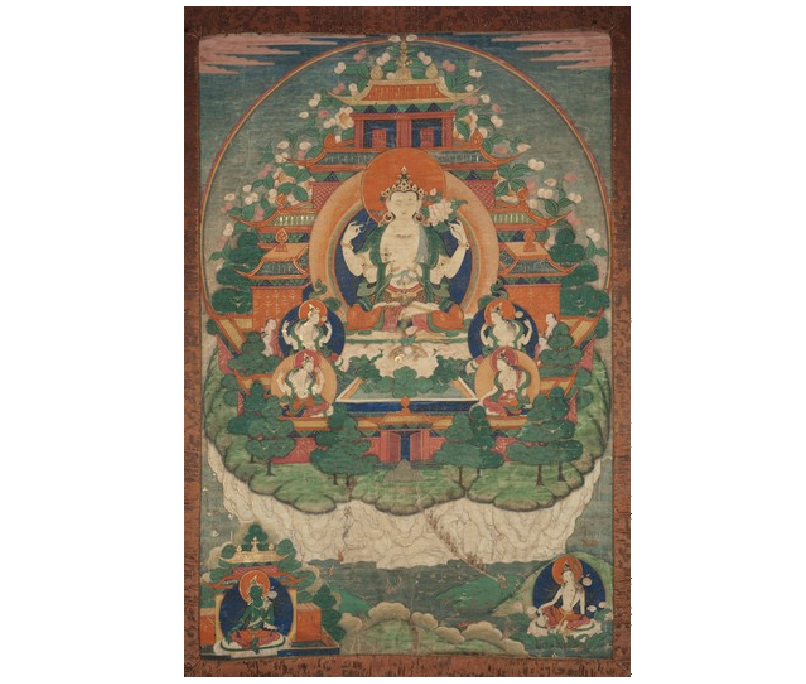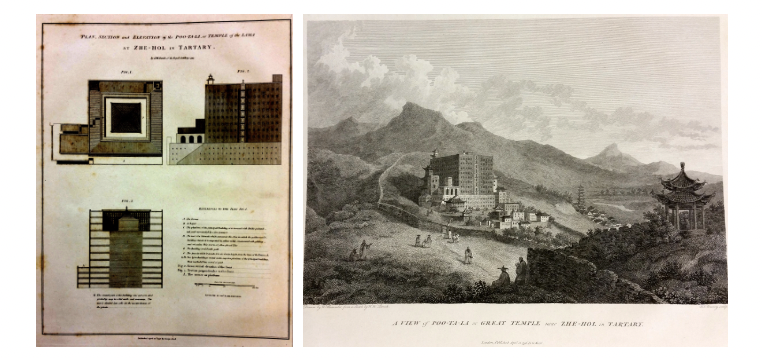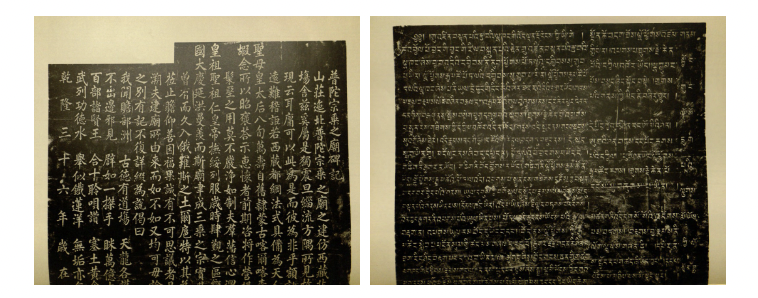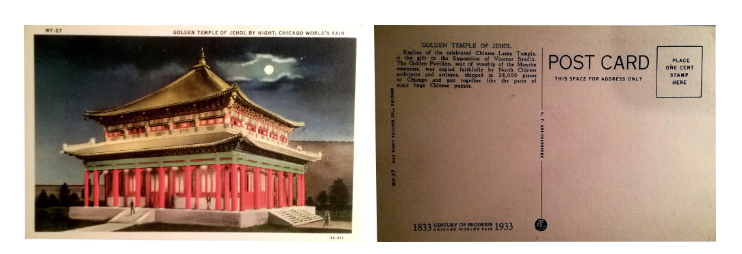Ian MacCormack — Graduate Student Associate and Ph.D. Candidate in the Committee on the Study of Religion at Harvard University — explains how replicas of Tibet’s world-famous Potala Palace exemplify Buddhist understandings of what it means to be an “original” or a “copy,” and how one of these copies nearly became the Harvard-Yenching Institute.

A God comes to Tibet
Gods have a habit of showing up in unexpected ways. In the Buddhist pantheon, buddhas and bodhisattvas are forever echoing through the world of our ordinary experience.
This fact of life was described in a number of Buddhist scriptures. One of the most famous images, from the Avataṃsaka sūtra (Huayan Jing), is of a single moon whose repeating images reflect on multiple bodies of water. The divinity described here is singular in its being but multiple in the world. By becoming visible, it becomes illusory.
The trope of the reflection often describes the bodhisattva Avalokiteśvara, known as Guanyin in China or Chenrezi in Tibet. This bodhisattva made the “taming” of Tibet a special project, repeatedly appearing there as kings, monks, tantric adepts, and — most famous of all — the rebirth series of the Dalai Lamas.

Where there is a bodhisattva, there is a bodhisattva’s home. Avalokiteśvara’s occupied a mountain known as “Potala.” On his Indian travels, the Chinese monk Xuanzang identified a “Mount Potalaka” located somewhere in present-day Tamil Nadu. Tibetan sources placed it off the southeast coast of India. Stories describe journeys to Potala by Buddhist adepts. There is even a Tibetan translation of a “Potala guidebook” for getting there, including all the right prayers to traverse this rather magical route.
At the summit of a new Tibetan government in Lhasa, the impressive “Great Fifth” Dalai Lama (1617–1682) brought the bodhisattva and his mountain to the forefront of Tibetan attention. He built a palace on a small hill in northwest Lhasa called Marpori (Red Hill) but also popularly called “Potala” in reference to a famous statue of Avalokiteśvara kept there.
Accounts of the fifth Dalai Lama and his palace often focus on political effects of claiming to be a bodhisattva and taking a bodhisattva’s home: legitimacy and secure patronage. It is hardly self-evident, however, whether this palace was supposed to be the Potala, or simply a Potala. It’s unclear what being a Potala would even mean, let alone the implications for thinking about the Dalai Lama’s divinity.
The distance between the two Potalas was both architectural and conceptual. By its very name and existence the new palace raised a question: Is it the Potala or not? The real thing, or just a fake? Is the Dalai Lama a god, or a copy of one?
Over time there have been many Potalas. In our eyes some may appear more “real” than others. Yet in each case, people have confronted the same basic problem: What to do with this multiplicity of the divine in the human world? What makes something real, and what does it mean to be a copy?

A Second Potala
The fifth Dalai Lama sometimes spoke of his palace as a “second Potala,” but also insisted that it was “not distinct from the real Potala.” It is derivative, yet something knits the two together. He often dramatized their relationship: when the bodhisattva projects into the world he puts on a “performance of life.” To conflate god and human would be like mistaking the character for the actor (or vice versa). Both are real in their own way. They can neither be collapsed nor pulled apart. The same must be said of the palace.
Sangyé Gyatso (1653–1705), the fifth Dalai Lama’s protégé and successor, confronted the same issue: how many Potalas are there and how do they relate? He argued that the bodhisattva’s abode was eternally ancient, at a level of reality beyond our apparent world. Invoking tantric language, it was “primordially present, built out of wisdom’s appearance to itself.” Only those with the right “fortune” could ever see it. That is why Avalokiteśvara projected into Tibet as a human, not a god, to build a second Potala by human hands for all to see.

A Chinese “Copy”
Meanwhile, on the other side of China, the enlightened emperors Kangxi and Qianlong (themselves depicted as bodhisattvas) were building their own potala copies. Northeast of Beijing, at Rehe 熱河 in Chengde (in present-day Hebei province), their summer residence included a series of temples replicating cultural monuments from Tibet and Central Asia. These “Outer Eight Temples” (外八廟) took after various models from the Buddhist world.
By far the largest was the Putuo Zongcheng (普陀宗乘), built from 1767–71, and as its name suggests, modeled after the Potala palace in Lhasa. In September 1793, on his embassy to China, Lord MaCartney met Qianlong at Chengde. The painter William Alexander produced a number of engravings based on sketches of the embassy, including several images of the Putuo Zongcheng.

The resemblance to the Lhasa palace is clear. It is also easy to see how it was a replica. For one thing the temple was built at reduced scale; for another, it was little more than a facade. The imposing red front wall is ersatz, with trompe-l’oeil windows. It is tempting to see this as mere fakery, a Disneyland home unsuitable for any “real” bodhisattva. But the truth is more complicated.

Qianlong’s quadrilingual stele commemorating the Putuo Zongcheng temple, dated to the mid-autumn month of Year 36 (September 9 — October 7, 1771), shows that even Qianlong cannot avoid dealing with the Potala Problem. He starts and ends by reflecting on it. He has even more Potalas to deal with: the Indian, the Tibetan, this Putuo Zongcheng temple, and — to make matters even worse — the island mountain of Putuo Shan (普陀山), China’s own “Mount Potala” off the Zhejiang coast, where Chinese devotees had been making pilgrimage to Guanyin himself for centuries.
Qianlong insists that his new palace “copies” the one in Tibet, not the one in the Chinese sea. He implies that the Indian original would have been even better, but was too far away to actually use. (Anne Chayet noted that the perspectival deformations of the Putuo Zongcheng suggest it was based on paintings of the Lhasa Potala, not firsthand observation.)

By speaking of a “copy” Qianlong is neither insisting that his palace is a fake, nor trying to undermine any claims about any other Potalas. It’s probably true, he concedes, that Avalokiteśvara goes to Putuo Shan and even sometimes reveals himself there. So why, he asks, should this be true for one but not the other? He concludes by asking: “So the Potala at this summer palace is like (與…一如) the Potala in Tibet, and also like the Potala in India. Why not like the Potala in the south sea too?” Qianlong makes us wonder: What makes a copy of a copy any more or less a copy than a copy? And would the gods even care?
The Bendix Temple
The story of the Potala doesn’t end here. The next home is an unexpected one: the 1933 Chicago World’s Fair.

When the Chinese government withdrew from the Chicago World’s Fair, exposition planners turned to Vincent Bendix, a Swedish-American industrialist and inventor, for an alternative solution. A few years earlier, Bendix bankrolled the Swedish explorer Sven Hedin to help him reconstruct a Chinese temple in America. Hedin chose the inner pavilion of Qianlong’s Potala replica at Chengde, which he called the “Golden Temple” after its gilded roof.
The Chicago Tribune article (pictured) suggests that Hedin actually intended to take the original structure, and was only prevented by its considerable disrepair. He commissioned Liang Weihua, a Chinese architect who worked on the National Library in Beijing, and a team of laborers to first build and then deconstruct and ship a perfect replica.

So we find yet another way of copying. This time the echo is not metaphysical, like the Lhasa building, nor formal, like the Chengde one. It is repeated in a way at once more and less real, more and less authentic to its source. The caption of one postcard from the World’s Fair quips that it was “put together like the parts of some huge Chinese puzzle.” Its meticulously numbered piece-by-piece correspondence is meant to suggest near equivalence with the original. But for visitors to the Fair the temple and its statuary is merely representational, standing in for a divinity located elsewhere, the object of some other person’s belief. This copy is a secular mimic of a sacred original.
This is almost, but not quite, where our story ends. It’s possible to trace one further ripple in the life of the Potala, probably the most ephemeral echo of all: a copy that was never made.

A Potala at Harvard?
In a strange twist, the Bendix temple — a duplicate of a portion of a replica of a copy of a bodhisattva’s home — very nearly ended up being relocated, of all places, right here on Divinity Avenue in Cambridge, Massachusetts (home to Harvard’s Department for East Asian Languages and Civilizations). It was (at least for a time) chosen as the new home for Chinese studies at Harvard.
As Cole Roskam has shown, after the 1939 Fair the temple was disassembled and stored at Oberlin College. Meanwhile the Harvard-Yenching Institute was still looking for a permanent home for its rapidly growing library. Oberlin officials approached the board of the Yenching Institute with the idea of selling them the Bendix temple. Their idea was that “the temple itself might function as a kind of living classroom in which those students no longer able to travel freely to China could nevertheless witness ‘the magnificence of Chinese culture in some of its aspects.’”
In June 1950, the board agreed to purchase the title to the temple and started drawing up plans. But the University rejected their proposals and in 1957 moved the Yenching Institute to the former Geographic Institute at Two Divinity Avenue, where it stands today. In 1970 Harvard finally transferred the title of the temple to the University of Indiana, and in 1998 it was repatriated (in a sense) to the Sven Hedin Foundation in Sweden.

Chinese studies at Harvard came close to occupying a Potala of its own. Ours was meant not only to provide a suitable home for the production of knowledge but also to be an object of knowledge itself. The difference between original and copy, in other words, would be just that between religion and the study of religion. Even if only virtually, Harvard too may claim a place among the many owners and occupants of Potala throughout history.
Moons on Water
It seems that every group gets the Potala they deserve. All are connected by this same thread: making sense of what it means to repeat, engaging religion through the echoes of a divinity at once too distant and too close to be seen. Gazing back from the present, it is tempting to consider these acts of mimicry, museum pieces, or academic centers as the very epitome of disenchantment.
When we view Potala from the other end of the telescope, however, we oddly find ourselves participating in a trajectory reaching back into the Buddhist tradition. After all, the question of Potala may have always been a question of copying, a question about what it means to encounter a divinity that is always already doubled, whose very nature within our world is to live by making copies of itself, moons that ripple and glow on the liquid surfaces of life.
Consider the debate about the reincarnation of the current, fourteenth Dalai Lama, a man who is also (somehow) Avalokiteśvara. On the one hand, the Dalai Lama invokes a doctrine of “willful rebirth” to insist that he has complete control over whether he will (or will not) return to our politicized and (for many Tibetans) unsafe and uncertain world. Beijing, on the other hand, invokes Qianlong’s institution of a “golden urn” lottery to claim that the state has long had the final say over transmigration.
It’s tempting to be cynical, about a communist state with the power to guide souls through the bardo. If (or when) one or more rival claimants emerge, some may be inclined to view one as authentic, the other a mere fake. All will have to answer the religious question of the copy. In this light even the most disenchanted of approaches is still doing significant religious work (perhaps in spite of itself) and making meaningful connections to a Buddhist past.
Ian MacCormack is a Ph.D. Candidate in the Committee on the Study of Religion at Harvard University and a Graduate Student Associate the Fairbank Center. His current research is on Buddhism and government in seventeenth-century Tibet.


